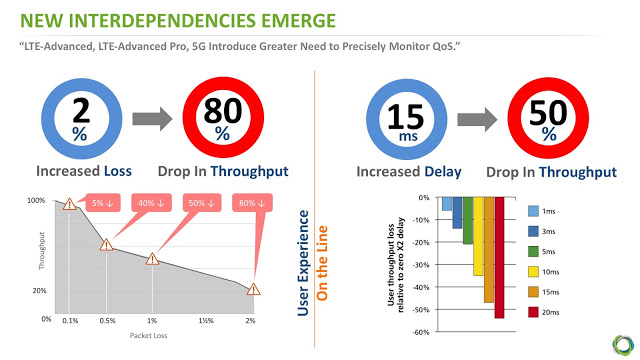When it comes to 5G’s effect on the mobile backhaul network, it’s best to think in terms of revolution, not evolution. This reality is creating both significant challenges and opportunities for network operators. Here are five ways to overcome those challenges and find success in the next generation of mobile service delivery.
1. Reconsider how backhaul networks are built
Quite simply, if operators continue to build backhaul as they currently do, it won’t cope in a 5G environment. To get an idea of how future backhaul might be architected, it helps to look at operators planning to roll out pre-standard 5G networks in the next few years.
Two ways those operators are preparing:
- Stop treating everything as a single class of service or use over-provisioning to keep up with bandwidth demand.
- Pay attention to the effect network traffic microbursts are having on impairing flows and QoE; respond by instrumenting the network so it can be monitored with sub-second precision in real time.
Network-wide quality of service (QoS) and quality of experience (QoE) is the foundation for building automated, software-defined networking (SDN) control using analytics.
2. Place an emphasis on automation
5G is a big deal for mobile network backhaul because of the size-scale, and complexity involved in next-generation service delivery. By GSMA estimates, by 2020 there will be a million times more sessions than today’s backhaul networks can handle.
Operators realize this scale means some form of automation or SDN is needed to maintain and optimize each service over the shared network resources it depends on. That means investing in a new type of virtualized instrumentation layer for end-to-end visibility.
3. Invest in network instrumentation
A uniform instrumentation layer, installed across the entire network, provides the network state and QoE insight necessary for effective control and optimization.
With virtualized instrumentation, network infrastructure itself can be used as a source for data about the performance of each application or each network slice. That data can then be analyzed for QoE and QoS, mixed with the subscriber state, and fed into analytics and control systems.
In this scenario, big and deep data provides subscriber trends, leading to new service and upsell opportunities. Fast data analytics, on the other hand, enable a closed feedback loop involving SDN control and service orchestration.
The good news is that, while it would take a couple of years to install an end-to-end instrumentation layer using traditional probes, with virtualization that timeline collapses dramatically. In some cases, networks in the quarter million endpoint range have been instrumented in 12 weeks or less.
Such speedy deployments are possible using highly virtualized instrumentation, running on commercial off-the-shelf servers, and using the existing network elements as endpoints. This is becoming a much simpler endeavor and much faster for the operator because they can use their existing stack to get things up and running quickly.
4. Monitor carefully how network KPIs correlate
Tier 1 operators now rolling out pre-5G networks are beginning to observe new, sometimes surprising, relationships between previously uncoupled metrics. For example:
- Small amounts of packet loss leading to a dramatic drop in throughput, impacting QoE
- Loss burst, where small bursts of control plane signaling loss results in significant outages
- Interactions between delay and throughput affecting QoE
- Video: The Future of QoE Monitoring
- Infographic: 5G QoE – Under Siege?
- Solution Brief: Delivering Fully-Assured Services Off-Net
- Blog Post: 4 Barriers Mobile Operators Face on the Road to 5G

 Improved delivery, better visibility: How Accedian and VMware are working together to help CSPs navigate the 5G world
Improved delivery, better visibility: How Accedian and VMware are working together to help CSPs navigate the 5G world
 Adding a new dimension of visibility to the Cisco Full-Stack Observability portfolio with Accedian Skylight
Adding a new dimension of visibility to the Cisco Full-Stack Observability portfolio with Accedian Skylight


